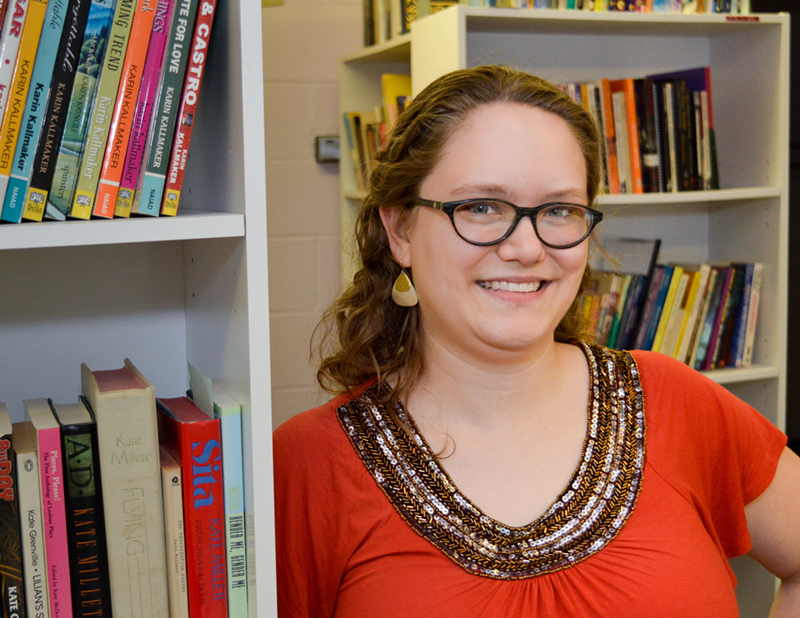Yerian, 26, now hopes her peers will discover the city’s legacy of LGBTQ+ activism and meet the people who pushed for rights long before Cincinnati elected Councilman Chris Seelbach, celebrated James Obergefell’s same-sex marriage case and banned conversion therapy for minors after Leelah Alcorn’s suicide.
At this year’s Pride Festival, Yerian will debut an exhibit of 50 years of stories about the individuals she calls Vibrant Kin — the name Yerian also chose for her project sponsored by People’s Liberty. In addition to the traveling display, she is holding events this summer to encourage conversations between generations.
“In two years, all over the country, there is going to be tons of stuff about the 50th anniversary of Stonewall, which is really important. But I wanted to honor what had happened here,” she says.
As a volunteer with the Ohio Lesbian Archives at Clifton United Methodist Church, Yerian indexed copies of Dinah, a local lesbian newsletter published from 1975 to 1997. In one issue, she found a reference to the founding of the homophile/gay right’s Cincinnati Mattachine Society in 1967 — two years before the uprising at New York’s Stonewall Inn. That stuck with her.
“Seeing that date tells us Cincinnati has formal activism going back a really long time,” Yerian says. “It wasn’t all on the coasts.”
Dinah editor Phebe (Karen) Beiser says she “sprang forth an activist” after coming out in 1971. She rallied at Fountain Square and City Hall, co-founded the Ohio Lesbian Archives and helped run Northside’s Crazy Ladies Bookstore from 1979 to 2004. She joined other Cincinnatians at the first National March on Washington for Lesbian and Gay Rights in 1979.
“I had one foot in the feminist movement and one in the gay one,” Beiser says via email. “Now, at 67, it’s amazing to realize that same-sex marriage is the law of the land.”
Vibrant Kin recounts the LGBTQ+ community’s highs and lows as it moved from battle to battle. “This is a really personal exhibit for me,” says Yerian, who came out at age 14. “I don’t see this as a conservative city anymore so much as I see it as a city with a lot of activism on all sides.”
The homophile wave in the 1960s focused on the decriminalization of sexual activity, but the non-confrontational societies soon yielded to the radical groups that emerged as the hippie movement grew. Those new organizations included Cincinnati Gay Community, which held the city’s first Pride event in 1973. On Jan. 1, 1974, Ohio dropped its sodomy law.
After achieving that stamp of legitimacy, Cincinnati’s activists moved to a new cause: a human rights ordinance. “By far, the longest arc of the story is the fight for nondiscrimination protections,” Yerian says. “It goes from 1977 to 2006 before actually, finally, getting nondiscrimination protections in the city that stick.”
During the unsuccessful 1977-78 effort to sway City Council to adopt an ordinance, activists were outraged when nearly 70 gay men were arrested in Burnet Woods and Mount Airy Forest over 10 days. Allegations of entrapment swirled around the police crackdown. “That, in a way, is Cincinnati’s ‘Stonewall moment,’ ” Yerian says. “Once this backlash starts, it’s a big awakening to a lot of people who may not have been involved in the formal movement.”
Pride returned in 1978 after a five-year absence. In 1982, The Cincinnati Enquirer published “Homosexuals: A Cincinnati Report.” It was a stark contrast to a 1964 series labeled “Cincinnati’s Hidden Problem,” which focused on crime. Some individuals used their real names and agreed to be photographed holding hands in a park or cooking at home.
“When you talk to older activists, it meant a lot to them,” Yerian says. “It meant change was coming.”
But lasting change still would take years. The elation over having City Council adopt a human rights ordinance in 1992 that included protection against bias based on sexual orientation was followed by deep disappointment next year when 62 percent of voters passed Issue 3, a referendum to block such rights.
“Everyone I talk to that was active in the 1980s, it was such a huge blow to them,” Yerian says. “They talk about just being tired after Issue 3. It’s sort of a community trauma.”
The Greater Cincinnati Gay and Lesbian Coalition, which once represented 40 organizations, disbanded in 1995. That same year, the Pride parade went away. And in 1998, the U.S. Supreme Court left intact Article XII of the city’s charter, which prohibited anti-discrimination measures on behalf of LGBTQ+ people.
By the time the gay community tried again in 2004, new coalitions had formed.
“There are still some of the older activists in this, but there’s sort of a generational changeover,” Yerian says. “They make the choice to come out to talk specifically about gay and lesbian rights.”
Voters repealed Article XII, and in 2006 City Council amended the human rights ordinance.
A decade later, Yerian is concerned about isolation between the generations. Last month, all ages met for SAGE Table, part of a national effort by Services & Advocacy for GLBT Elders.
Older people spoke of the loss of places like Crazy Ladies for making friends. “The more we’re accepted, the less we need a place that accepts only us,” says Sandy Dulaney, 72, of West Chester with some wistfulness. Yerian says younger people want to hear the history, but they also want their experiences to be honored. For instance, “queer” is a word that still carries hurt for senior gays. “But for younger people it can symbolize liberation and something that feels right in terms of labeling themselves,” Yerian says.
Beiser, the archivist, knows there’s work ahead but is optimistic.
“The young people have so much energy!” she writes. “I trust that these activists will carry the torch of fairness and freedom.”
VIBRANT KIN will premiere noon-9 p.m. Saturday at the Cincinnati Pride Festival. More info: vibrantkin.org.


